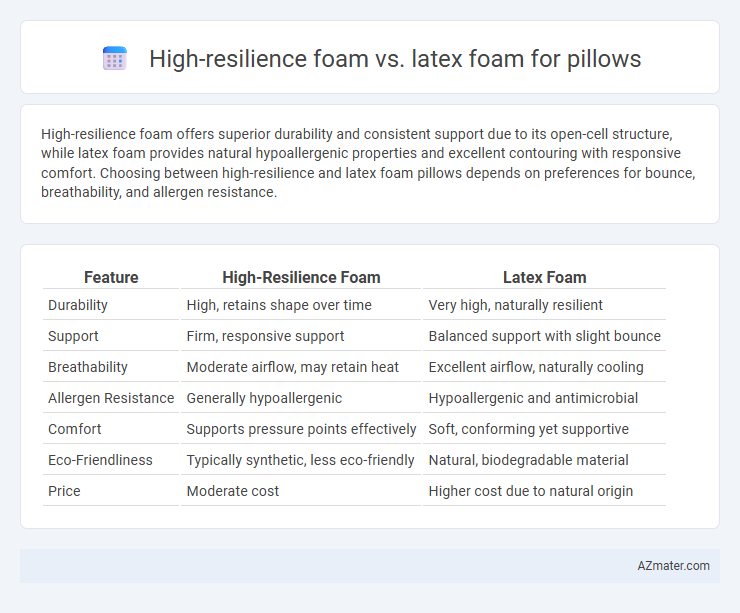High-resilience foam offers superior durability and consistent support due to its open-cell structure, while latex foam provides natural hypoallergenic properties and excellent contouring with responsive comfort. Choosing between high-resilience and latex foam pillows depends on preferences for bounce, breathability, and allergen resistance.
Table of Comparison
| Feature | High-Resilience Foam | Latex Foam |
|---|---|---|
| Durability | High, retains shape over time | Very high, naturally resilient |
| Support | Firm, responsive support | Balanced support with slight bounce |
| Breathability | Moderate airflow, may retain heat | Excellent airflow, naturally cooling |
| Allergen Resistance | Generally hypoallergenic | Hypoallergenic and antimicrobial |
| Comfort | Supports pressure points effectively | Soft, conforming yet supportive |
| Eco-Friendliness | Typically synthetic, less eco-friendly | Natural, biodegradable material |
| Price | Moderate cost | Higher cost due to natural origin |
Introduction to Pillow Foam Materials
High-resilience foam pillows offer exceptional support and durability thanks to their open-cell structure that enhances airflow and maintains shape under pressure. Latex foam pillows provide a naturally hypoallergenic, breathable, and responsive sleep surface, conforming to the head and neck with consistent elasticity. Both materials contribute to spinal alignment and pressure relief, but differ significantly in their composition, breathability, and resilience properties.
What is High-Resilience (HR) Foam?
High-Resilience (HR) foam is a type of polyurethane foam known for its exceptional elasticity and durability, providing strong support and maintaining its shape over time. Its open-cell structure allows for better airflow and breathability compared to traditional foams, making it a popular choice for pillows aimed at pressure relief and comfort. Compared to latex foam, HR foam offers a similar level of responsiveness but tends to be more affordable and versatile for varying firmness preferences.
What is Latex Foam?
Latex foam is a natural or synthetic material made from the sap of rubber trees or petrochemicals, known for its durability, elasticity, and hypoallergenic properties. It provides excellent support and pressure relief by conforming to the body's shape while maintaining breathability and resistance to dust mites and mold. Unlike high-resilience foam, latex foam offers a cooler sleep experience due to its open cell structure and superior airflow.
Comfort and Support: HR Foam vs Latex Foam
High-resilience foam offers superior support with its ability to quickly regain shape, providing consistent pressure relief and spinal alignment. Latex foam delivers exceptional comfort due to its natural elasticity and breathability, offering a cooler sleep surface with a responsive feel. Both materials excel in durability, but HR foam better suits those seeking firmer, more supportive pillows, while latex foam appeals to sleepers desiring a softer, contouring experience.
Durability and Longevity Comparison
High-resilience foam offers superior durability with a dense cellular structure that resists sagging and maintains support for over a decade, making it ideal for long-term pillow use. Latex foam boasts natural resilience and inherent antimicrobial properties, ensuring longevity by resisting wear, dust mites, and mold for 8 to 10 years while providing consistent comfort. Both materials excel in durability, but high-resilience foam typically outlasts latex foam in everyday durability, especially under frequent compression and use.
Breathability and Temperature Regulation
High-resilience foam pillows offer excellent breathability due to their open-cell structure, promoting airflow that helps maintain a cooler sleep environment. Latex foam pillows provide superior temperature regulation with natural moisture-wicking and antimicrobial properties, which effectively reduce heat buildup and enhance comfort. Both materials support proper ventilation, but latex foam typically excels in maintaining consistent coolness throughout the night.
Allergy and Hypoallergenic Properties
High-resilience foam offers excellent support and durability, but it can sometimes trap dust mites and allergens, making it less ideal for allergy sufferers. Latex foam, especially natural latex, is naturally hypoallergenic, resistant to dust mites, mold, and bacteria, making it a superior choice for individuals with allergies or sensitive skin. Choosing a pillow with natural latex foam enhances sleep hygiene by minimizing exposure to common allergens.
Environmental Impact and Sustainability
High-resilience foam pillows offer durability and support but tend to have a higher environmental footprint due to petroleum-based materials and energy-intensive manufacturing processes. Latex foam, especially natural or organic latex, provides a more sustainable option with biodegradability and renewable sourcing from rubber trees, reducing carbon emissions and landfill waste. Choosing certified eco-friendly latex supports healthier ecosystems and lower chemical use, enhancing overall environmental benefits compared to synthetic foams.
Price and Value Considerations
High-resilience foam pillows typically offer a more affordable price point compared to latex foam, making them a budget-friendly option for many consumers. While latex foam is generally more expensive, it provides superior durability and natural hypoallergenic properties that may justify the higher initial investment. Evaluating cost-effectiveness involves balancing the upfront price with longevity and comfort, where latex often delivers greater long-term value despite its premium cost.
Choosing the Right Foam Pillow for Your Needs
High-resilience foam offers exceptional support and durability with excellent pressure distribution, making it ideal for individuals seeking firm, long-lasting comfort. Latex foam provides natural elasticity and breathability, promoting cooler sleep and hypoallergenic benefits, perfect for those sensitive to allergens. Choosing the right foam pillow depends on whether you prioritize resilience and support or natural materials and ventilation for your sleep preferences.

Infographic: High-resilience foam vs Latex foam for Pillow
 azmater.com
azmater.com